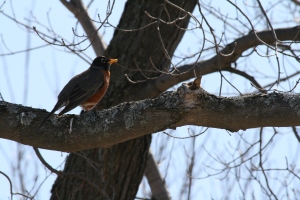Chirp!
tweet, twitter, tweet tweet…
Ah, the sounds of Spring. Birds have returned and the air is filled with their music. Robins flit back and forth, mourning doves low in the trees, and of course the Canada Geese honk noisily overhead. It seems like one moment the world is devoid of life, and the next the trees are filled with our winged friends again. Despite the occasional smattering of snow, it is the return of migratory birds that truly heralds spring.
One of the first things that most birds do when they return to their summer homes is to find a partner. From there, they build a nest and commence to breed. While some birds breed several times a season, like the prolific mourning doves which have up to six broods a season, others may breed only once, like the noisy blue jay.
In either scenario, the location of the bird’s nest can be quite important. Does the bird make a cup shaped nest in the crook of a tree, like many songbirds, such as red-winged blackbirds or robins? Or rather do they use a cavity, such as a personally pecked out tree for use by a woodpecker family. Conversely, a natural cavity would fit an owl’s needs better. Of course, many species are habituated to humans and choose to nest in buildings or even in human-made nesting boxes, like chickadees, nuthatches or american kestrels.
Attracting Birds to your Yard
If you want to bring more birds into your neighbourhood this spring, think about how you can attract them. Hanging a birdfeeder will encourage birds to swing into your yard, and if kept well-stocked, hopefully stay. Having a source of water for drinking or washing, like a bird-bath or pond, will also encourage our feathered friends to visit for a while. Trees provide shelter, a place to breed and food for many birds as well. Of course, if you also have furry friends like cats, that might discourage birds from sticking around for too long. Just noting.
If you plan to plant a tree to attract birds and other wild life, try to pick something native to the area. They will be the most attractive for your desired species. Hawthorns, elders and red maples are good for nesting, and attracts species such as robins, grosbeaks and eastern kingbirds. Oaks, pines and beech provide food sources for birds like nuthatches, goldfinches and blue jays. The list goes on from there and is extensive. Of course, you also need to select trees by available lighting, moisture content, and climate. If bird watching is part of the pleasure derived from planting a tree, then it is worthwhile doing a little research. If you have questions about specific tree’s needs or require help in selecting or planting a tree for your property, please feel free to contact us at CLC Tree Services. We are always here to help.
So grab your binoculars and sit back to enjoy a little bird watching this spring. (Yes, despite the snow this week, we still think it is Spring.) Have a great week!




You must be logged in to post a comment.